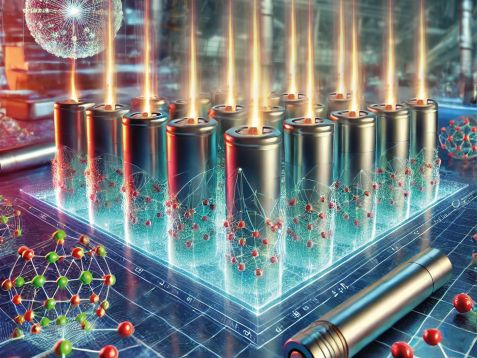MLZ is a cooperation between:
 > Technische Universität München
> Technische Universität München > Helmholtz-Zentrum Hereon
> Helmholtz-Zentrum Hereon
 > Forschungszentrum Jülich
> Forschungszentrum Jülich
MLZ is a member of:
 > LENS
> LENS > ERF-AISBL
> ERF-AISBL
MLZ on social media:

MLZ (eng)
Lichtenbergstr.1
85748 Garching
17.04.2025
How heat harms Li-ion Batteries
When charged, the graphite anode in a Li-ion battery (LIB) can be exposed to temperature- driven changes, causing structural degradation and negatively affecting its performance. X-rays and neutrons help to reveal the underlying processes behind these changes.

The thermal stability of the graphite anode is a decisive factor for the performance, service life and safety of lithium-ion batteries, as temperature-related changes during charging can lead to structural degradation. © Created with AI
The thermal stability of lithiated graphite has been identified as a crucial factor affecting efficiency in LIBs, particularly during fast charging or high discharge rates. Both low and high temperatures induce changes in the behaviour of graphite that impact the overall lifespan and safety of LIBs.
Low-temperature stability
At temperatures below -33°C, no substantial degradation of lithiated graphite was observed. Minor changes in diffraction intensities and the appearance of additional reflections from frozen electrolyte components were detected during in-situ characterisations. However, these changes did not impact the structural stability of the graphite, but did hinder the Li-ion diffusion during operation at low temperatures.

Tobias Hölderle, PhD student at the high-resolution structure powder diffractometer SPODI at the FRM II and first author of the study © Bernhard Ludewig; FRM II / TUM
In contrast, overheating the Li intercalated graphite anode leads to irreversible structural changes occurring across the full range of states of charge. Dr. Anatoliy Senyshyn, instrument responsible of the neutron powder diffractometer SPODI at the MLZ and coordinator of this study, says: “The recorded diffraction patterns unambiguously indicate the formation of various side products upon heating, resulting in the loss of active lithium and harming stable cell operation.”
Side reactions at high temperatures
Calorimetric studies further identified the involvement of the binder and electrolyte residues in the degradation process, which result in the formation of passivation layers on the graphite particle surfaces. Stabilising the electrolyte composition could help mitigate these effects and improve overall battery longevity.
Original publication:
T. Hölderle, M. Monchak, V. Baran, A. Kriele, M.J. Mühlbauer, V. Dyadkin, A. Rabenbauer, A. Schökel, H. Ehrenberg, P. Müller-Buschbaum, A. Senyshyn, Thermal Structural Behaviour of Electrochemically Lithiated Graphite (LixC6) Anodes in Li-ion Batteries, Batteries & Supercaps 7, e202300499 (2024)
DOI: 10.1002/batt.202300499
More information:
Experiments were carried out at P02.1 (PETRA III / DESY), SNBL (ESRF) and SPODI (MLZ).
MLZ is a cooperation between:
 > Technische Universität München
> Technische Universität München > Helmholtz-Zentrum Hereon
> Helmholtz-Zentrum Hereon
 > Forschungszentrum Jülich
> Forschungszentrum Jülich
MLZ is a member of:
 > LENS
> LENS > ERF-AISBL
> ERF-AISBL
MLZ on social media:


